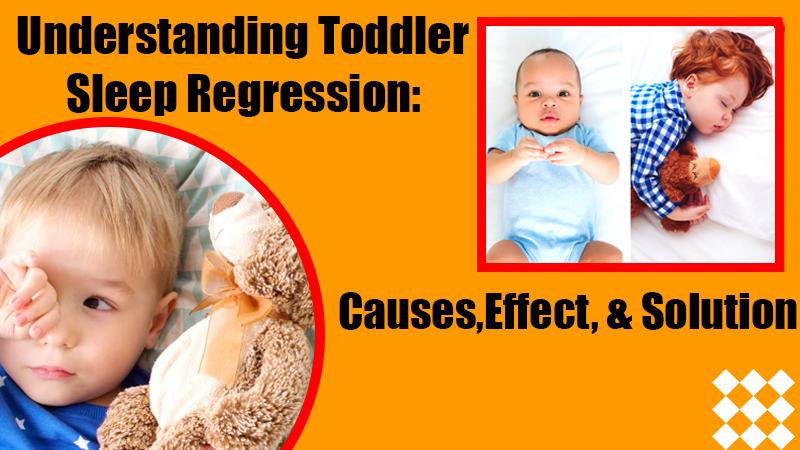Sleep regression is a common and often challenging phase in a toddler’s development that many parents face. Just when you thought your child had settled into a somewhat predictable sleep routine, you may find yourself dealing with disrupted nights, bedtime battles, and a seemingly sleepless child. This can be frustrating and exhausting for both parents and toddlers alike.
In this blog, we will delve deep into the world of toddler sleep regression. We’ll explore the causes behind this phenomenon and its potential effects on your child’s well-being and your own.
Contents
What is Toddler Sleep Regression?
Toddler sleep regression is a term that may send shivers down the spine of any parent who’s experienced it. But what exactly is it? Simply put sleep regression in toddlers refers to a period of time when your once peaceful, slumbering child suddenly begins to experience difficulties in falling asleep, staying asleep, or both.
This regression typically occurs around the age of 18 months to 2 years, although it can happen earlier or later, and it’s marked by significant disruptions in your child’s sleep patterns. These disruptions can manifest as frequent night awakenings, bedtime battles, and a generally cranky disposition during the day.
During this sleep regression toddler phase, it’s common for parents to wonder what went wrong with their previously good sleeper. The causes of toddler sleep regression are multifaceted and can be attributed to various factors, including cognitive and developmental changes, teething, separation anxiety, and newfound mobility.
As your child grows and their brain rapidly develops, they might experience increased curiosity, awareness, and an enhanced ability to express their emotions – all of which can contribute to nighttime awakenings and fussiness. While these regressions can be frustrating, it’s essential to remember that they are a normal part of a toddler’s development. With the right strategies and support, you and your child can navigate through this phase together.
Toddler Sleep Regression Ages
Toddler sleep regression is not a one-size-fits-all phenomenon. It occurs at different ages and stages of a child’s development. Understanding when to expect these regressions can help parents prepare for potential disruptions and cope more effectively.
Here’s an overview of the toddler sleep regression chart for the various ages at which toddler sleep regressions commonly occur:
8 Months: Around 8 months of age, many toddlers experience sleep regression due to developmental milestones, such as crawling and teething. These changes can lead to increased nighttime wake-ups.
12 Months: The first birthday often brings with it a sleep regression. This is usually linked to a surge in separation anxiety as your toddler becomes more aware of their surroundings.
18 Months: At this age, toddlers may go through a significant sleep regression, often related to cognitive development and the emergence of new fears or anxieties.
2 Years: The terrible twos can also include sleep regressions. This time, it may be influenced by your toddler’s growing independence and desire to assert control, including at bedtime.
2.5 Years: Another common sleep regression occurs around 2.5 years, usually marked by nightmares and night terrors, as your child’s imagination and understanding of the world expands.
Toddler Sleep Regression Causes
Toddler sleep regression can be a bewildering experience for parents, but uncovering the underlying causes can help ease the journey. Cognitive development plays a significant role in this phenomenon, as toddlers rapidly acquire new skills and understanding, leading to heightened mental activity that can disrupt their sleep patterns.
Teething is another common culprit, causing discomfort and pain that makes it challenging for toddlers to rest peacefully. Separation anxiety, a normal part of a child’s emotional development, often intensifies around this age, leading to nighttime awakenings and a desire for comfort.
Changes in routine, transitions, or stressful life events, such as moving to a new home or welcoming a new sibling, can also trigger sleep regression by creating feelings of insecurity and anxiety. By recognizing these causes, parents can better support their toddlers through this trying phase.
- Cognitive development and increased mental activity
- Teething discomfort and pain
- Separation anxiety and the need for comfort
- Changes in routine or stressful life events
How Long Does Toddler Sleep Regression Last
Parents who are in the midst of dealing with toddler sleep regression often find themselves yearning for the light at the end of the tunnel. One of the most pressing questions they face is, “How long will this last?”
“The duration of toddler sleep regression can vary, making it a particularly elusive phase to predict. In most cases, a single episode of sleep regression may last anywhere from 2 to 6 weeks, though it can sometimes extend longer.”
The timeline often depends on the cause, the child’s age, and how consistently parents apply strategies to address the regression. While it can be a trying period, understanding the potential duration can help parents mentally prepare and stay patient as they work to reestablish a regular sleep routine for their little ones.
How to Handle Toddler Sleep Regression
Dealing with toddler sleep regression can be a trying experience, but rest assured, there are effective strategies to help both you and your child navigate this challenging phase. When faced with disrupted sleep patterns and bedtime battles, it’s essential to stay patient and remember that this is a normal part of your child’s development.
Tips for Handling Toddler Sleep Regression:
Maintain a Consistent Bedtime Routine:
A structured and consistent bedtime routine can provide a sense of security for your toddler. Include calming activities like a warm bath, a bedtime story, and soothing lullabies to signal that it’s time to sleep.
Create a Comforting Sleep Environment:
Ensure your child’s sleep space is comfortable, dark, and quiet. Consider using a nightlight or white noise machine to help ease any fears of dark or unfamiliar sounds.
Offer Comfort and Reassurance:
During night awakenings, provide comfort and reassurance without creating new sleep associations. Try to comfort your toddler in their own bed or room to encourage self-soothing.
Stay Calm and Patient:
It’s natural to feel frustrated, but maintaining a calm and patient demeanor is crucial. Your child may be looking to you for guidance and assurance during this time.
Address Teething Discomfort:
If teething is a contributing factor, offer age-appropriate teething remedies to help alleviate pain and discomfort. Consult your pediatrician for safe options.
Adjust Naps:
Ensure your child is getting the right amount of daytime sleep. Too much or too little can disrupt nighttime sleep. Adjust nap schedules accordingly.
Seek Support and Advice:
Don’t hesitate to reach out to your pediatrician for guidance or consider consulting with a sleep expert if the regression persists and significantly impacts your family’s well-being.
Consider Gradual Transitions:
If the regression is linked to developmental milestones or transitions (e.g., transitioning from crib to bed), make the changes gradually and explain them to your child to ease the adjustment.
Maintain a Healthy Diet:
A balanced diet can contribute to better sleep. Avoid caffeine or sugary foods close to bedtime, and ensure your child is well-fed during the day.
Stay Consistent:
Consistency is key when implementing these strategies. Stick with the routine and be patient, as it may take time for your toddler to readjust to a regular sleep pattern.
Should You Let Toddler Cry It Out During Sleep Regression
One of the most debated topics in the realm of toddler sleep regression is whether or not to let your child cry it out during these challenging phases. “Cry it out” is a method in which parents allow their child to cry for a period of time before intervening.
It’s a strategy often used to encourage self-soothing and independent sleep habits. However, its application during sleep regression is a matter of personal parenting philosophy and can be influenced by your child’s specific needs and the underlying causes of the regression.
For some parents, allowing a toddler to cry it out during sleep regression may seem like a tough-love approach based on the belief that it helps children develop better sleep habits. However, it’s crucial to assess whether your child’s crying is due to the typical frustrations of sleep regression or if there is another underlying issue, such as illness or intense anxiety.
Final Thoughts
Understanding and coping with toddler sleep regression is a crucial aspect of parenthood. It’s a challenging phase that many parents face, but with knowledge, patience, and the right strategies, you can help your child through it and ensure that both you and your little one get the rest you need. Remember, toddler sleep regression is a natural part of your child’s development, and it won’t last forever. With consistency, a comforting sleep environment, and support, you can help your toddler return to a more peaceful sleep routine.
As parents, your love and understanding are the best tools you have to guide your child through this phase and ensure a good night’s sleep for the entire family.







